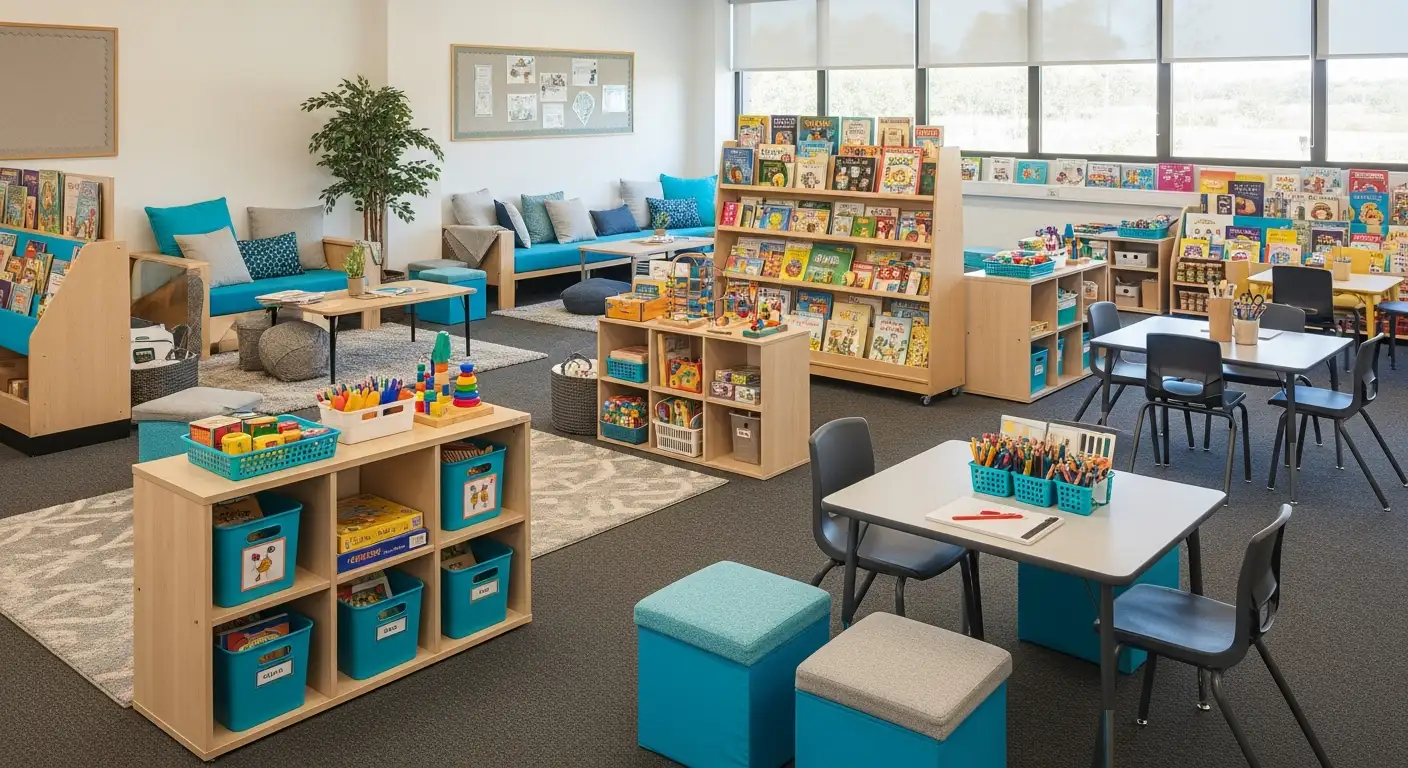Essential Autism Teaching Strategies for Success

Effective Autism Teaching Strategies
Implementing effective teaching strategies for students with autism requires a tailored approach. This section discusses the importance of Individualized Education Plans (IEPs) and collaborative IEP development to achieve successful educational outcomes.

Utilizing Individualized Education Plans (IEPs)
Individualized Education Plans (IEPs) are vital in providing personalized education that meets the unique needs of students with autism. These plans ensure that every child receives education tailored to their specific abilities and potential, recognizing the inadequacy of a one-size-fits-all approach Teachers Institute.
IEPs serve multiple purposes:
The goals within IEPs are not simply aspirations; they are carefully crafted milestones that are regularly reviewed and adjusted to reflect the student’s evolving needs Teachers Institute.
Collaborative IEP Development
The creation of an IEP involves collaborative efforts among educators, parents, therapists, and the student. This collaborative approach emphasizes building relationships and setting SMART (Specific, Measurable, Achievable, Relevant, Time-bound) goals tailored to the student’s progress Teachers Institute.
A well-structured IEP development process includes:
StageDescriptionInitial AssessmentGathering baseline data regarding the student's abilities and challenges.Goal SettingDeveloping realistic and specific educational goals using input from all stakeholders.ImplementationExecuting teaching strategies and supports outlined in the IEP in the classroom.Regular ReviewMonitoring progress and making necessary adjustments to the IEP based on ongoing assessments.
This cooperative approach helps ensure that the educational strategies employed are effective and relevant, benefiting the student and promoting growth in various areas of their learning journey. Tailoring education specifically for each student through collaborative IEP development serves as a cornerstone in implementing effective autism teaching strategies.
Visual Strategies for Autism Teaching
Incorporating visual strategies into autism education can significantly enhance learning outcomes. These strategies facilitate comprehension, support transitions, and promote effective communication.
Incorporating Visual Aids in Reading
Visual aids play a vital role in aiding reading comprehension for students with autism. Tools such as symbols or pictures can assist children in identifying main ideas within texts and remembering vocabulary meanings. This approach not only supports their reading skills but also fosters learning. Given that reading difficulties are common among children with Autism Spectrum Disorder (ASD), implementing autism reading comprehension strategies becomes essential for strengthening their learning experiences.
Benefit of Visual AidsDescriptionImproved ComprehensionSupports the identification of main ideas and vocabulary meanings.Enhanced Social SkillsVisuals can illustrate expected behaviors and social norms, aiding social interactions.Stronger Learning OutcomesFocused reading strategies lead to better educational results.
Visual Supports for Transitions
Visual supports during transitions are crucial for helping students focus on their destinations. Providing visual aids that students can carry with them promotes understanding of the various cues within the school environment. This method not only helps refocus attention but also improves compliance and understanding of transitions.
Visual supports are beneficial for several reasons:
Advantages of Visual SupportsDescriptionStructure and RoutineProvides a clear framework, enhancing predictability in activities.Encouragement of IndependenceAllows students to navigate environments with confidence.Reduced Frustration and AnxietyVisuals offer clarity, helping to alleviate feelings of overwhelm.Facilitation of InteractionVisual aids provide consistent communication opportunities, improving social engagement.
These visual strategies are instrumental in creating an effective learning environment for students with autism by enhancing comprehension and facilitating smoother transitions.
Benefits of Visual Strategies
Visual strategies play a crucial role in enhancing the learning experience for students with autism. By utilizing visual tools and aids, educators can address comprehension issues and central coherence deficits commonly observed in this population.
Enhancing Comprehension with Visual Steps
Using visual aids, such as symbols or pictures, during reading can help students with autism identify the main ideas in the text and remember the meaning of vocabulary terms, thus supporting their comprehension and learning. This method can also apply to teaching social skills by providing visuals of expected behavior and social norms paired with key vocabulary, enhancing social interaction with adults and peers [1].
Providing visual steps, such as task trees or task analyses, assists students with autism in preparing for different subjects. By breaking down tasks into individual steps with corresponding visuals, students can better understand the expectations and independently transition with the correct materials, fostering their ability to follow instructions effectively [1].
Visual StrategyDescriptionBenefitsTask TreesA step-by-step visual representation of a taskHelps students understand expectations and independently manage tasksSymbol-Supported TextsText accompanied by symbols or picturesEnhances reading comprehension and vocabulary retentionVisual SchedulesA daily or weekly schedule using picturesProvides structure and routine, aiding in transitions
Addressing Central Coherence Deficits
Individuals with autism often exhibit central coherence deficits, which can affect their ability to process contextual information and understand the bigger picture. The use of visuals helps to provide additional context and expectations within their environment, promoting understanding and participation in classroom activities [1].
Visual aids, such as visual schedules and social stories using pictures and written descriptions, significantly enhance communication for individuals with high functioning autism. They can help navigate daily routines and improve social understanding [3].
Central Coherence SupportExampleImpactVisual AidsPhotographs, symbols, or colored cardsImproves understanding and reduces anxiety in social situationsStructured VisualsVisual schedules showing daily activitiesAids in comprehension and supports independence
By leveraging these visual techniques, educators can effectively cater to the unique learning needs of students with autism, promoting their academic and social success.
Importance of IEPs and Special Education
Individualized Education Plans (IEPs) play a vital role in the education of students with autism. These plans ensure that every child receives an education tailored to their specific needs, abilities, and potential. Recognizing the uniqueness of each student, IEPs address the inadequacy of a standardized approach to education.
Role of IEPs in Educational Settings
IEPs are crucial for students eligible for special education services. Each IEP describes the goals set for a student for the school year and outlines any special support needed to help achieve those goals. The Individuals with Disabilities Education Act (IDEA) mandates that teachers of students with special needs plan, implement, and monitor educational strategies to foster success in school.
The IEP process involves several key components:
ComponentDescriptionGoals and ObjectivesClear, measurable goals for academic and personal growthSupport ServicesSpecific services and accommodations required to reach goalsService ReviewAnnual review to update goals and services based on progress (KidsHealth)
Providing Free Appropriate Public Education
The IDEA also requires states to provide free appropriate public education (FAPE) to students eligible for special education from ages 3 to 21. This education must occur in the "least restrictive" environment, encouraging children with disabilities to learn alongside their non-disabled peers whenever possible.
IEP services can vary based on individual needs and may be provided in several different settings:
SettingDescriptionRegular Education ClassroomInclusion in a general education setting with supportSeparate ClassroomSpecialized environment for more focused instructionSeparate SchoolDedicated school for students with significant support needs (KidsHealth)
It is essential to review the IEP annually to update goals and ensure that service levels meet the student's evolving needs. Continuous progress monitoring throughout the school year is also crucial to ensure that students are making strides towards their established goals, with the possibility to adjust the IEP as necessary.
Communication Strategies for Autism
Communication is a critical aspect of autism education. Implementing effective communication strategies can significantly enhance engagement and learning experiences for individuals with autism. This section discusses clear communication techniques and the use of visual aids.
Clear Communication Techniques
Clear communication is essential when interacting with individuals on the autism spectrum. This involves using simple, concrete language and avoiding idioms or abstract phrases that may lead to confusion.
TechniqueDescriptionUse of Short SentencesShort and straightforward sentences help reduce ambiguity and make instructions clearer.Consistent VocabularyUsing the same words consistently allows individuals to understand and anticipate what is being communicated.Direct RequestsDirectly stating what is expected can minimize misunderstandings. For example, instead of saying "Can you put that away?" say "Please put the book on the shelf."Positive ReinforcementProviding positive feedback reinforces desired behaviors and communication efforts, helping build confidence.
Enhancing Communication with Visual Aids
Visual aids are powerful tools that enhance understanding and communication for students with autism. They provide visual context that complements verbal communication, addressing potential central coherence deficits. Some effective visual supports include:
Type of Visual AidPurposeVisual SchedulesHelp structure daily routines, allowing students to anticipate and prepare for upcoming activities. They improve understanding and participation in tasks.Social StoriesUtilize pictures and written descriptions to explain social situations, enhancing understanding and context.Task AnalysesBreak down tasks into step-by-step visuals, assisting students in completing assignments independently.Portable Visual SupportsDevices or apps that provide quick access to visual aids, enhancing communication in various settings. Visuals should be durable, easy to store, and personalized.
Using these communication strategies, educators and caregivers can create a more inclusive and supportive learning environment, enabling individuals with autism to express themselves and understand their surroundings more effectively.
Impact of Applied Behavior Analysis (ABA)
Applied Behavior Analysis (ABA) is a systematic approach to understanding and changing behavior. It is widely recognized for its effectiveness in teaching skills and reducing problematic behaviors in children with autism spectrum disorder (ASD).
Understanding Applied Behavior Analysis (ABA)
ABA therapy utilizes principles derived from B.F. Skinner’s theory of operant conditioning, focusing on modifying behavior through reinforcement techniques [6]. By using rewards and incentives, ABA promotes positive behavior changes and encourages skill acquisition. Over the past 60 years, ABA has evolved into a comprehensive framework that includes various treatment models, focused intervention practices, and teaching methodologies tailored for children and youth with ASD.
Notable ABA models include:
ModelDescriptionEarly Intensive Behavioral Intervention (EIBI)Focuses on comprehensive early intervention for young children with autism.Early Start Denver Model (ESDM)Integrates developmental and behavioral approaches, emphasizing early intervention.Learning Experiences: An Alternative Program (LEAP)Combines ABA with typical peer interactions to enhance social skills.
Research emphasizes the efficacy of ABA, with studies revealing significant improvements in areas such as socialization, communication, and expressive language in children undergoing ABA therapy [2].
ABA Therapy for Autism Treatment
ABA is recognized as a "best practice" for treating children and youth with ASD, receiving endorsements from the governments of Canada and the United States. Several studies indicate that when ABA interventions are applied in early childhood and are sustained over time, they produce favorable outcomes.
For example, a landmark study showed that 47% of children who participated in ABA reached normal levels of intellectual and educational functioning, compared to only 2% in a control group. Additionally, a meta-analysis highlighted that ABA interventions yield substantial improvements in:
Area of ImprovementOutcomeLanguage developmentSignificant gains in expressive language skillsIntellectual functioningEnhanced cognitive abilitiesDaily living skillsBetter acquisition of self-care skillsSocial functioningImproved interactions and friendships
ABA therapy employs structured techniques to build essential skills while addressing behavior challenges. This targeted approach helps children with ASD thrive academically and socially. By understanding the positive impact of ABA, educators and parents can utilize effective autism teaching strategies to support children's development.
References
[2]:
[3]:
[4]:
[5]:
[6]:
Recent articles

How ABA Therapy Improves Behavior In Inclusive Classrooms
Transforming Inclusive Education: The Role of ABA Therapy in Behavior and Skill Development

Teaching Personal Hygiene Routines Through ABA Therapy
Empowering Independence: How ABA Therapy Transforms Hygiene Skills in Children with Autism

The Importance Of Generalization In ABA For Long-Term Outcomes
Maximizing Life Skills Through Effective Generalization in Autism Therapy

How Functional Communication Training Reduces Problem Behaviors
Transforming Challenging Behaviors Through Functional Communication Training

ABA Therapy For Teaching Coping Strategies During Stressful Situations
Harnessing ABA Therapy to Equip Individuals with Autism for Stressful Moments

How ABA Therapy Builds Foundations For Independent Adulthood
Unlocking Potential: ABA Therapy's Role in Nurturing Independent Adulthood



